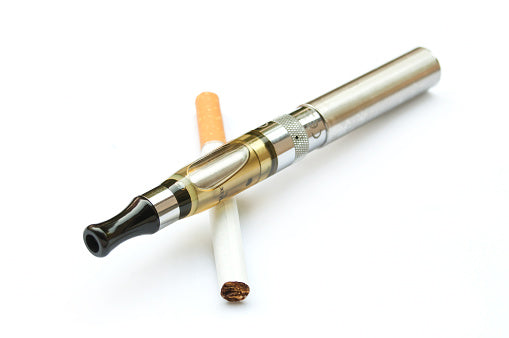
EVALI Concerns: Electronic Cigarette Vs. Cigarette
E-cigarettes also referred to as vapes, are getting increasingly well-liked. Many people think that using e-cigarettes is healthier than smoking regular cigarettes. Australians are vaping more frequently than ever, especially young people. Therefore it's critical to comprehend the long-term health dangers.
WHAT IS VAPING OR SMOKING E-CIGARETTES?
The act of vaping is the usage of an electronic cigarette, often known as a "vape," which uses cartridges filled with liquids or "juice," which usually contains nicotine, flavor enhancers, and different chemicals with been proven to be hazardous. A heated aerosol, or vapour, is created from the liquid and inhaled into the user's lungs.
Some vapes are made to imitate tobacco cigarettes, cigars, and pipes, whereas others are made to resemble commonplace objects like pens and USBs. Even though e-cigarettes don't use tobacco, many liquids still have extremely addictive nicotine and other substances. When inhaled, these substances may be harmful. Some are added to the product to give it a fruit, alcoholic, or confectionery flavour. Researchers at Curtin University tested the chemicals and toxicity of 52 flavor-based e-liquids available over the counter in Australia as part of a groundbreaking study funded by the Minderoo Foundation, Lung Foundation Australia, and the Scottish Masonic Charitable Foundation of Western Australia. The investigation uncovered a concoction of chemicals that cause grave worries regarding the security of these items and their hazards to young people's respiratory health.
VAPING IN AUSTRALIA

In Australia, it is against the law for anybody to consume, sell, or purchase nicotine to use e-cigarettes without a prescription. All states and territories, apart from Western Australia, allow the sale of vapes and e-cigarettes but not the purchase or sale of liquid cartridges containing nicotine. Due to this, a lot of consumers purchase goods and liquid cartridges online.
SMOKING CESSATION
Doctors may occasionally recommend nicotine-containing e-cigarettes to help patients quit smoking. There is minimal proof that applying this strategy will result in the desired result. Further regulations were put in place by the Australian government as of 1 October 2021 to restrict young people's access to nicotine-containing e-cigarettes. It includes making it necessary to import nicotine-containing e-cigarettes and liquids with a valid prescription.
VAPING EFFECTS ON YOUNG PEOPLE
E-cigarettes have the potential to act as a "gateway" to nicotine dependence and traditional cigarette use. Numerous studies have shown that trying out e-cigarettes boosted the usage of traditional cigarettes, especially among young people. More than one in five (21.7%) young Australians between the ages of 18 and 24 and 7.6% of those between the ages of 15 and 17 have used a vaping device. This study is according to the Australian Bureau of Statistics. Given that the replies were from an adult residing in the same family, it's likely that these numbers are underreported.
E-cigarettes are made with fruit, alcoholic, and candy flavours to appeal to young people. According to a study, one in five e-liquids you can buy over the counter in Australia include nicotine and a mixture of other dangerous substances, and all have misleading labeling. Experts are worried that these products may breed a new generation of nicotine addicts and increase significant health problems, including cancer and lung disease.
The Lung Foundation Australia has created a collection of information to close the knowledge gap about vaping and e-cigarettes. You may arm yourself with factual and fact-based information thanks to the materials below, created by and for young Australians, educators, parents, and caregivers.
HEALTH EFFECTS OF VAPING E-CIGARETTES

Vaping is risky and might be harmful. The short-term health effects of vaping have been linked to nausea, mouth and airway irritation, vomiting, chest pain, and heart palpitations, though the long-term health effects are still unknown. Contrary to the widespread belief, vaping involves an aerosol of hazardous particles, not just harmless water vapour.
These aerosols emit and contain a variety of dangerous substances, such as:
- Acrolein and formaldehyde can harm the lungs permanently.
- Propylene glycol is toxic to human cells.
- Especially in regions of the adolescent brain that control attention, learning, mood, and behavioural control, nicotine, a highly addictive substance, can endanger the still-developing teenage brain.
Additionally, vaping is linked to future cigarette smoking adoption and can be seen as a "gateway" to increased risk and health issues.
HOW MUCH NICOTINE DOES AN E-CIGARETTE HAVE?
The amount of nicotine in e-cigarettes varies greatly, with some having levels on par with or higher than that in conventional cigarettes.
- Since studies have revealed mislabelling as a widespread problem, labels are not always a trustworthy predictor of nicotine concentration.
- The amount of nicotine delivered to a certain user depends on how an e-cigarette is used or changed.
- Some e-cigarette products work just as well to deliver nicotine as a cigarette. For instance, the manufacturer of JUUL claims that the product delivers nicotine up to 2.7 seconds faster than other e-cigarettes and has a nicotine level similar to regular cigarettes. It can supply higher nicotine doses with fewer irritability thanks to nicotine salts' ability to reduce the pH of e-liquids.
- JUUL devices were initially released in the US with 5% nicotine salt pods. In what has been dubbed a "nicotine arms race," JUUL's rivals followed following and started providing nicotine salt concentrations as high as 7%. However, in 2018, JUUL debuted a reduced nicotine pod with 3% nicotine strength. Puff Bars, a well-known disposable product, uses nicotine salts and can be purchased with up to 5% nicotine levels.
- Concerns regarding the possibility of addiction are also raised by the nicotine level of devices like JUUL and the rate of nicotine administration. According to a 2018 Truth Initiative study published in Tobacco Control, 63% of current JUUL users who are teens and young adults did not seem aware that the product typically contained nicotine. Aesthetic cigarette use in the morning and e-cigarette use at night after rising with a yearning is among the anecdotal symptoms of acute dependence that young people are experiencing.
VAPING AND EVALI
A major medical disease known as EVALI occurs when a person's lungs are harmed by chemicals found in e-cigarettes and other vaping devices.
Vaping involves heating a small amount of liquid so it can be breathed as vapour using an electronic cigarette, also known as a vape pen, mod, or tank. Propylene glycol and glycerol are common foundation components in vape liquids that help produce vapour. However, they might also contain additional substances, including synthetic tastes, nicotine, THC, and cannabidiol (CBD) oil.
Symptoms include:
- Chest pain
- Shortness of breath
- Cough
- Rapid heartbeat
- Fever and chills
- Rapid and shallow breathing
- Diarrhea, nausea, vomiting, and abdominal pain
Causes
Scientists have connected EVALI to vitamin E acetate, an artificial type of vitamin E included in several THC-containing vaping products. The substance can harm the lungs if inhaled. In one investigation, vitamin E acetate was present in the lung fluid of 48 of 51 EVALI patients collected throughout 16 states. The vitamin was not present in fluid lung specimens collected from healthy individuals.
Vitamin E acetate is believed to be the primary contributor to EVALI in light of these and other investigations. Additional compounds may also influence the disease in vaping goods containing nicotine and THC.
Risk Factors
Use of a vaping device, either currently or in the past, is the main risk factor for EVALI.
The use of THC-containing vaping products has been linked to the disease. Over 80% of patients hospitalized for EVALI, according to the CDC, admitted using vaping devices that included THC, while many also admitted using nicotine-containing items. The CDC adds that rather than purchasing their vaping supplies from stores, approximately 80% of EVALI patients using THC-containing e-cigarettes did so from "informal sources," such as relatives, friends, suppliers, or online sources.
Diagnosis
Due to the symptoms of this lung disorder being similar to those of other respiratory infections, including pneumonia and even the seasonal flu virus, EVALI can be difficult to diagnose.
Since there's no single test for EVALI, a doctor will perform tests to rule out other possible diseases and ailments. It's known as a "diagnostic of exclusion."
Your doctor will enquire about your current usage of e-cigarettes and whether you used any vaping products that contained nicotine, THC, or both before making a diagnosis. During the physical examination, your physician will use a stethoscope to listen to your lungs, monitor your heartbeat, and use a pulse oximeter to determine how much oxygen is in the blood. The diagnosis usually requires a chest X-ray or computed tomography (CT) scan, revealing the lungs' hazy-appearing patches (opacities). In contrast, healthy lungs have a clear backspace. Your doctor could also recommend blood tests to rule out further potential reasons for your sickness.
Treatment
Many patients diagnosed with EVALI require hospital treatment where drugs may be carefully watched, and breathing support is easily accessible.
Treatments could consist of:
- Corticosteroids: A kind of medicine that lowers bodywide and pulmonary inflammation
- Supportive Care: Through a nasal cannula, patients can get extra oxygen. In more serious situations, they might be placed on a mechanical ventilator or an oxygenation device.
- Antibiotics: Since it can be challenging to distinguish between EVALI and bacterial infections, you may administer these medications to the patient if diagnostic test results are still being processed.
- Antivirals: Antivirals may be utilised, particularly during the influenza season, because EVALI symptoms are similar to several viral diseases.
ARE ELECTRONIC CIGARETTES SAFER THAN REGULAR CIGARETTES?

It is well acknowledged that e-cigarettes produce fewer chemicals present in cigarette smoke. However, it's becoming clearer that this frame is inadequate to fully convey the story regarding the effects on individual health. The most recent research indicates that e-cigarettes might cause specific health risks and that comparing them to cigarettes might not be the only useful way to assess how they affect a person's health. Indeed, some academics have questioned whether e-cigarettes are safer than tobacco products in light of the mounting evidence of potential health concerns associated with e-cigarette usage.
The current increase in vaping-related lung damage is further evidence that you should use e-cigarettes cautiously. Although the CDC recently recognised vitamin E acetate as a chemical of great concern, the agency has been careful to emphasize that it has not found a single cause and persists in advising warnings concerning all vaping as the investigation continues. Many cases in the recent outbreak of vaping-related lung illness appear to be linked to THC vaping. At the very least, this outbreak starkly illustrates the risks of an unregulated market for inhaled drugs without any premarket consumer safety review.
The usefulness of e-cigarettes as a cessation aid still needs to be proven. Thus, until an FDA review, the safest, most successful method of quitting should combine counseling, nicotine replacement therapy, and FDA-approved cessation medications like varenicline. There's also a great deal of variation within the product category and no such thing as a standard e-cigarette, even though the fundamental technology behind e-cigarettes is consistent. The items deliver varying levels of nicotine and possibly dangerous substances, including heavy metals like cadmium, lead, nickel, tin, and copper. They also have various components, hardware, and manufacturing processes. This diversity highlights the significant and ongoing need for premarket examination of these items and makes it challenging to make general recommendations for the category's public health.
Customers must constantly be aware of what they are purchasing and its safety, especially regarding products that deliver chemicals through regular inhalation. Researchers are debating whether e-cigarettes are safer than conventional cigarettes in light of mounting evidence of potential health concerns and lung damage associated with e-cigarette usage.
